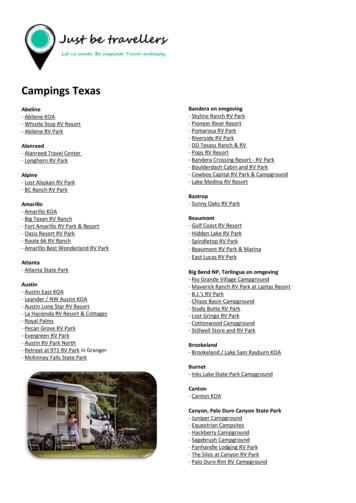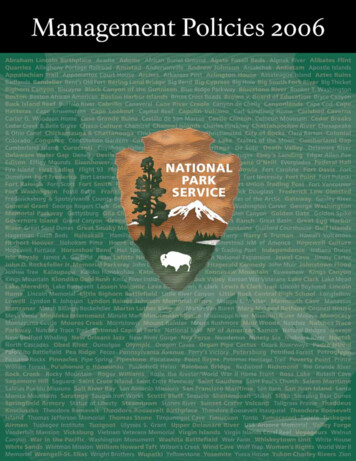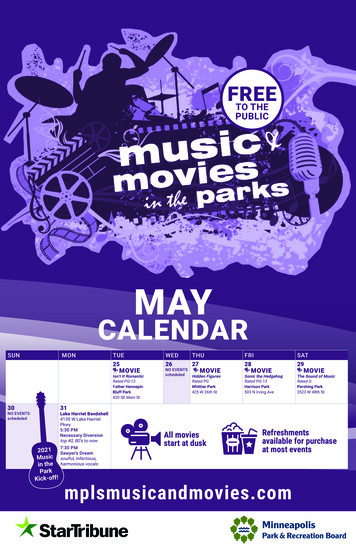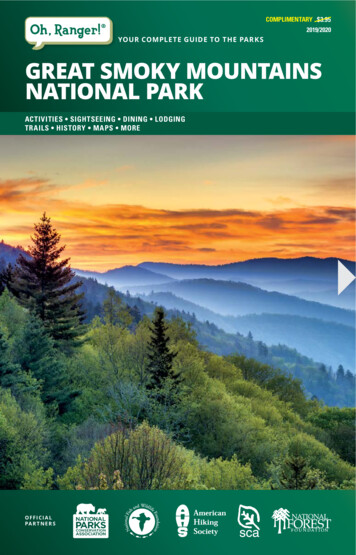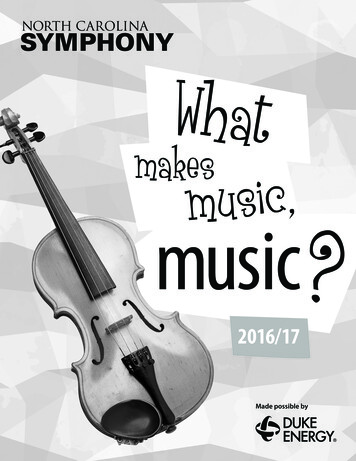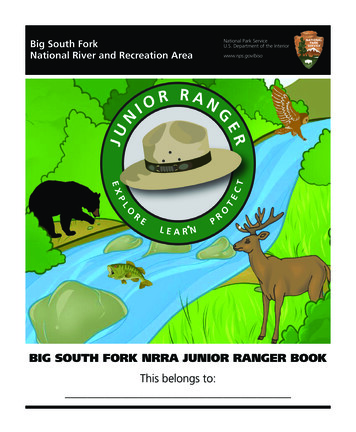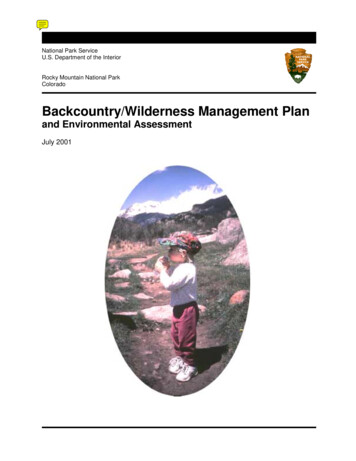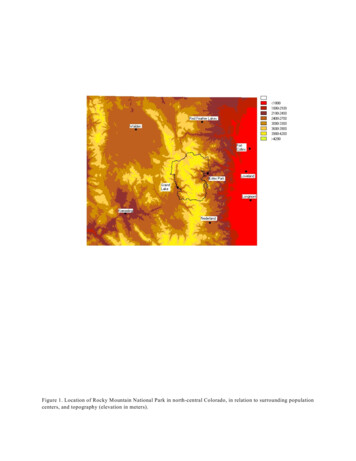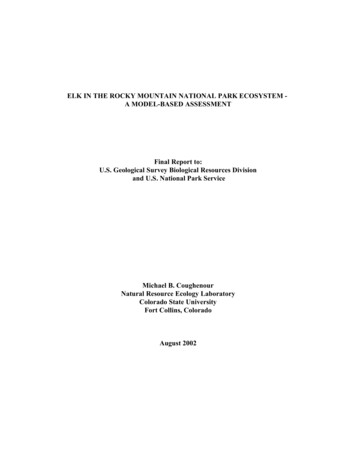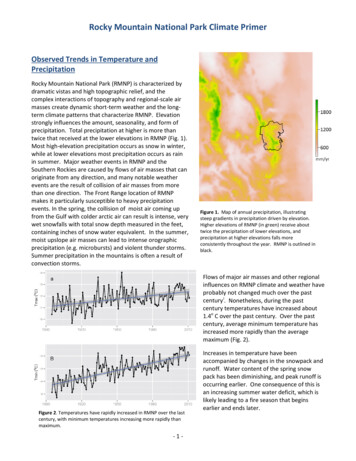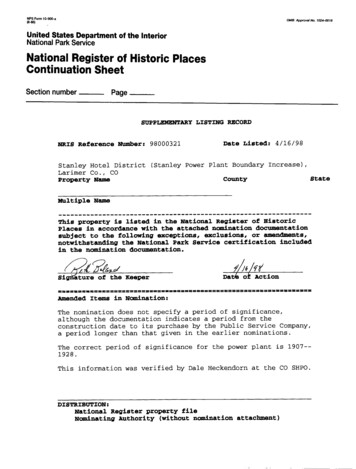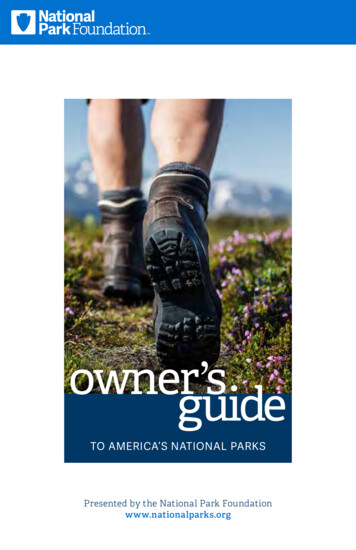
Transcription
owner’sguideTO AMERICA’S NATIONAL PARKSPresented by the National Park Foundationwww.nationalparks.org
Yosemite National Park
owner’sguideTable of ContentsIntroduction1Map: Sections Overview2Section 14Section 1a8Section 212Section 2a16Section 320Section 424Section 528Section 632Section 736Section 840Section 944Section 1048Section 1152Section 1256Section 1360Section 1464Section 1568Section 1672Section 1776Section 1880Section 1984Section 19a88Section 2092Section 2196Section 22100Park Directory104NATIONALPARKS.ORG III
About the author:Kurt Repanshek has been covering national parks for more than three decades.Following a stint with The Associated Press, his freelance career has spawnedguidebooks to the national parks and articles for Smithsonian, Audubon, NationalWildlife, and many other publications. He is the founder and editor-in-chief ofwww.nationalparkstraveler.com, a web-zine that provides daily coverage of thewonders of the National Park System.Maps provided courtesy of the National Park Service.Design and layout by Mary Frances Craig, Miesha Dennis and Kirsten Ogren.Special thanks to Angela Hearn, Dan Puskar and Mark Shields for their contributions. 2016 National Park Foundation.1110 Vermont Avenue, NW, Suite 200, Washington, DC 20005www.nationalparks.org
“ There is nothing so American as our national parks.The scenery and wildlife are native. The fundamentalidea behind the parks is native. It is, in brief, that thecountry belongs to the people.”–PRESIDENT FRANKLIN DELANO ROOSEVELT, 1936IN 1872, America did something unprecedented proclaimingYellowstone the world’s first national park, setting aside morethan one million acres of wilderness as a “public park”, not for theprivileged, but for the benefit and enjoyment of all people.For more than 100 years American citizens have continued thiswork of transforming the great landscapes of our country andthe important sites from our history into an extraordinary publictreasure. Today, because of their vision and action, each of us isa shared owner in over 400 national park sites spanning 18 millionacres and including high mountain peaks, deep valleys, sacredbattlefields, celebrated monuments, picturesque seashores,extraordinary museum collections and that is just the beginning!We are truly owners of the world’s greatest collection of nature,history and culture.Our parks remind us who we were with when we first saw bison,an eagle, or a bear cub in the wild. They share the stories of ourpast in the places where they happened and introduce us to largerthan life figures from Abraham Lincoln to Martin Luther King, Jr.,to Sacagawea. They are the places that inspire us, refresh us, andconnect us so proudly as Americans.There is so much to discover in our national parks! Let this Owner’sGuide be your first step on your next national park adventure.GO PARKS!NATIONALPARKS.ORG 1
The Owner's Guide to America’s national parks is designed tomake your park experience better than ever. With this guide, youcan easily find national parks by state, region, and in territoriesoutside the continental United States. Separate sections areincluded for cities with high concentrations of national parks suchas Boston, Washington, D.C., New York City and San 17NMOK14TX21AK
The numbers highlighted below direct you to the appropriate mapsection in the Owner’s Guide (example: national parks in Utah andColorado are found on Map 16.) Each section contains a summary ofwhat you’ll see in the area as well as “what not to miss” at each park.To help with planning your next national park adventure, you will finda complete directory of national parks and an abbreviations key for allpark designations in the back of the guide.MEVTMNWI11IAILIN910NJDE4Maryland &Delaware5Washington, AAL8FL22HIGUASPRVINATIONALPARKS.ORG 3
1Few regions of the National Park System capture the toiland artistry of our young nation as well as New England.From New Bedford, the “richest city in the world” during thewhaling age of the 19th century, and Springfield that armedthe country to the art history reflected at both Weir Farmand Saint-Gaudens home, this region blends industrialismwith masterworks to define America and Americans.
IN THE AREA If there’s a central theme thatruns through the national parks found inNew England, it wouldn’t be a stretch to callit artistic flair. While Acadia National Park nodoubt showcases natural beauty on MountDesert Island with its rocky shores, babblingbrooks and pine-shaded granite mountains,dig into the park’s history and you’ll discoverone of the finest art movements in thiscountry’s history. Thomas Cole, consideredthe founder of the Hudson River School oflandscape painting that also gave us theworks of Frederic Edwin Church and AlbertBierstadt, captured the island’s scenery withhis paintings in the 1840s and 1850s.Those settings caught the interest of EastCoast aristocrats, who flocked to MountDesert Island to escape summer’s heat andhumidity. Soon a service industry arose tocater to these visitors, who included theRockefellers, Morgans and Vanderbilts. Someof their dollars helped create today’s nationalpark; the carriage paths, for example, wereinstalled by John D. Rockefeller, Jr., an ardentsupporter of the national park movement.And Mr. Cole hasn’t been forgotten, as artistscontinue to flock to Acadia to capture itsmany moods. what not to missCONNECTICUTWeir Farm NHSTake guided tours of the art studios andhistoric home.MAINEAppalachian NST(See West Virginia)Acadia NPVisit late May-early June for wildflowers;first half of Oct. for foliage.Katahdin Woods and Waters NMSpread across a wild landscape offeringspectacular views of Mount Katahdin.Saint Croix Island IHSThe interpretive trail features six bronzestatues of Native Americans and Frenchsettlers.MASSACHUSETTSCape Cod NSEnjoy mesmerizing ocean views along thepristine beaches and grassy uplands.Lowell NHPDon’t miss the Boott Cotton Mills Museum,with 88 operating loomsWeir Farm National Historic SiteNATIONALPARKS.ORG 5
Elsewhere in the region, Weir Farm HistoricSite in Connecticut not only showcases theart of 19th Century painter J. Alden Weir,who opened his home to other artists, butwelcomes today’s painters to seek inspiration.Saint-Gaudens National Historic Site in NewHampshire pays homage to AugustusSaint-Gaudens, considered to be perhapsAmerica’s best sculptor, and; while the NewBedford Whaling National Historical Parkin Massachusetts traces America’s whalinghistory, peek into the Seamen’s Bethel andyou’ll find a pew where Herman Melvillecaptured some of his inspiration for Moby Dick.There’s surf and sun to be embraced in NewEngland, as well, with Cape Cod NationalSeashore offering 40 miles of sandy beaches,cranberry bogs and adventures in the dunes.And then, of course, seemingly binding NewEngland together is the Appalachian NationalScenic Trail, a 2,174-mile footpath that isanchored in the north atop Mount Katahdin inMaine and in the south on Springer Mountainin Georgia. With numerous spurs connectingto it like interstate on-ramps, the trail can beenjoyed for an afternoon or a month. what not to missMASSACHUSETTS (CONT.)New Bedford Whaling NHPSpend a day touring the historic district;stay for Art, History and ArchitectureGallery night (2nd Thurs. monthly)Springfield Armory NHSSee an exhibit featuring the largestcollection of experimental and standardmilitary arms in the US.NEW HAMPSHIRESaint-Gaudens NHSTour the galleries, gardens and house;explore the hiking trails.RHODE ISLANDBlackstone River Valley NHPThe Blackstone River powered America'sfirst successful cotton spinning mill.Roger Williams N MEMCombine this visit with trips to the StateHouse and historic Benefit Street.VERMONTAcadia National ParkMarsh-Billings-Rockefeller NHPEnjoy hiking trails in the nation’s oldestsustainably-managed forest. This is thefirst national park to focus on the historyof conservation.
Cape Cod National Seashorewhat will you see?Adrift in the Atlantic Ocean a long stone’sthrow off the Maine coast, lobster-clawshaped Mount Desert is a rumpled, and attimes angular, landscape of granite, timberand water. The island stood up to glaciersthousands of years ago and today enduresconstant beatings from the Atlantic.You can find the roof of Acadia NationalPark atop Cadillac Mountain, a 1,532-foottall granite hump that is the highest pointon the north Atlantic seaboard. Reachingthe summit via the 3.5-mile-long CadillacSouth Ridge Trail, you stride easily throughcool coniferous forests that slowly give wayto rocky outcrops and expansive views fromthis jewel of the Atlantic. Frenchman’s Bayand its many isles, the horizon-stretchingAtlantic Ocean, and the Gulf of Maine allcome into view from Cadillac’s graniteshoulder. The trek is reflective of the returnto nature sought by the High Society thatretreated to Mount Desert Island early in the20th century.Just as key to experiencing Acadia is a visitto the Jordon Pond House, where theysmear fresh strawberry preserves on warm,oversized popovers, pedaling through thewoods along the peaceful carriage paths, orrock-hopping along the cobbled coastlinesin search of tide pools with their anemones,sea urchins, and sun stars.Cadillac MountainAcadia NPNATIONALPARKS.ORG 7
1aThe area around Boston, Massachusetts, is one of thecountry’s richest when it comes to American history. Hereyou’ll find the birthplace of the Revolutionary War, a historicsite honoring the father of landscape architecture in theUnited States, and another in tribute to one of the nation’sfinest poets. Being so close to the Atlantic Ocean, it’s nosurprise that this region is also home to one of the country’searliest, and most important, seaport towns.
IN THE AREA Frederick Law Olmsted mighthave been the quintessential jack of all trades:Scientist, farmer, journalist, publisher, drygoods clerk, and gold mine manager. Today,though, Olmsted is remembered for hiscontributions to landscape architecture.Indeed, his travels throughout the worldand the United States introduced him toa wide variety of landscapes. He put allthese experiences together as he designedpark settings across the country, startingwith Central Park in New York City. Otheraccomplishments included projects atYosemite National Park and countlessurban settings from Boston to Chicago andLouisville. From the Frederick Law OlmsteadNational Historic Site you can join rangers forwalking tours to some of the parks Olmsteddesigned in Boston.At nearby Longfellow National Historic Siteyou can explore 19th century literature andthe arts, tour the home of American Literarylegend, Henry Wadsworth Longfellow, orBoston National Historic Park what not to missBOSTONAdams NHPThe birthplace, home, and final resting placesof John Adams and John Quincy Adams, aswell as both first ladies.Boston African American NHSTake the Black Heritage Trail walking tour maps and guides available free at the AfricanMeeting House.Boston Harbor Islands NRABeachcombing, boat riding, fishing, hikingand kayaking are all favorites. Programsavailable May-Oct.Boston NHPExplore the Old State House, Faneuil Hall,Paul Revere House, Old North Church andmore along the Freedom Trail.Frederick Law Olmsted NHPTour historic grounds and watch a film aboutAmerica’s leading landscape architect.John Fitzgerald Kennedy NHSGuided home tours are available Wed-Sun,May-Oct.Longfellow House-Washington’sHeadquarters NHSThe Longfellow Summer Festival of Musicand Poetry lasts---- June-Sept.Minute Man NHPThe North Bridge, Minute Man Statue,and Battle Road are global symbols of thestruggle for freedom.Salem Maritime NHSTour the wharves, historic buildings,neighborhoods, and 18th century garden.Saugus Iron Works NHSMuseum features a working waterwheel,and other machinery from American heavyindustry.NATIONALPARKS.ORG 9
simply enjoy the two acres that buffer thehouse and the nature drawn to it frombustling Cambridge. Not only do rangersprovide insights to Longfellow, but they alsotouch on General George Washington, whostayed in Longfellow’s home during the Siegeof Boston in 1775-1776.At Faneuil Hall you can imagine the scenewhere Samuel Adams and others decried thetaxes England was levying on the colonies.Any visit to Boston must include a visit toBoston National Historical Park. Boston, afterall, was the backdrop for the first battle of theRevolutionary War. Time in downtown Boston iswell spent following the red-brick Freedom Trailthat leads you past 16 nationally historic sites– meeting houses, cemeteries, even the OldNorth Church where Paul Revere placed twolanterns to warn of an impending British attack.North of Boston lies Saugus Iron WorksNational Historic Site, where iron-making inthe United States was brought to life, andSalem Maritime National Historic Site, whichin its day was a bustling seaport that sawRevolutionary War privateers come and goalong with merchants who traveled to the FarEast for goods.Salem Maritime National Historic SitewrongphophowrongtotoAlso worthy of a visit while in Boston is theBunker Hill Monument, which tells the story ofthe first major battle of the Revolutionary War.
Minute Man National Historical Parkwhat will you see?With the Atlantic Ocean so close, is it anysurprise the National Park System extendsinto the water? And what you’ll find atBoston Harbor Islands National RecreationArea will likely surprise you.True, there are tide pools to explore, dunesto walk, and even some pretty good fishing.wrong photoBut that’s only the most obvious. While themain battlegrounds of the Civil War werefar to the south in Virginia, Pennsylvania,Tennessee, and the Carolinas, on GeorgesIsland you’ll find a Civil War-era fort. Theisland initially was using for farmingbut, in 1825 the government acquiredit for defense purposes and built FortWarren, which also held its fair share ofConfederate prisoners. To this day thefort supposedly is haunted by the ghostof a prisoner’s wife who, legend has it, washanged for aiding his escape.Throughout Boston Harbor IslandsNational Recreation Area you’ll find 39islands, each with its own personality.Some are little bigger than rocky outcropsthat birds rest on. Others, such as GrapeIsland, have trails, campsites, and awonderfully abundant collection of wildberries.Boston Harbor IslandsNational Recreation AreaNATIONALPARKS.ORG 11
2Images of the American frontier in the 18th century mixwith beach-combing in the Atlantic and presidential historyat National Park System sites in New York. Also foundhere is a small chapel where women first gathered to talkabout expanding their rights in the United States, as well asbattlefields that witnessed impressive American victoriesover the British during the Revolutionary War.
IN THE AREA Upstate New York during theRevolutionary War was a frontier wildernessthat challenged tactics. The Colonial Armywas stretched both by the expanse of landas well as the superior numbers of theBritish forces. But twice in a handful ofmonths smaller Colonial forces repelledlarger British armies. what not to missThe battle commemorated by today’sSaratoga National Historical Park ended withBritish surrender, a feat that helped convincethe Colonials that they could indeed succeedin gaining independence. A few monthsprior to that victory, Colonial forces at FortStanwix held off a superior British contingentand in the process helped thwart plans todivide and conquer the colonies. Today thestory of that battle is told at Fort StanwixNational Monument.Eleanor Roosevelt NHSTour home and gardens, explore thewalkways and trails of Eleanor Roosevelt’shome.Presidential history is spread across NewYork State. Sagamore Hill National HistoricSite on Long Island marks the last homeof Theodore Roosevelt, the country’s 26thSaratoga NationalHistorical ParkNEW YORKAppalachian NST(See West Virginia)Fire Island NSTake a tour of the Fire Island Light House,explore a 300-year-old American Hollyforest, enjoy the seashore.Fort Stanwix NMTour the fort, which has been almostentirely reconstructed to its 1777appearance.Home of Franklin D. Roosevelt NHSTour the home and adjacent library andmuseum; visit FDR and Eleanor Roosevelt’sgrave sites.Martin Van Buren NHSPlan to spend an hour and a half touringthe home and gardens of the Nation’seighth President.Sagamore Hill NHSTour the home of Theodore Roosevelt,explore the Old Orchard Museum.Saratoga NHPTake an auto or biking tour of thebattlefield.Theodore Roosevelt Inaugural NHSTheordore Roosevelt was sworn in hereas President on Sept. 14, 1901 after WilliamMcKinley was assassinated.Vanderbilt Mansion NHSTake guided tours of the home, and explorethe formal garden and grounds.Women’s Rights NHPVisit the birthplace of the women’s rightsmovement in the United States. Tour themuseum, historic buildings and homes.NATIONALPARKS.ORG 13
president. During his time in office the homeserved as Roosevelt’s summer White House.On the opposite side of the state, in Buffalo,you can find the Theodore Roosevelt InauguralNational Historic Site, where Roosevelt wassworn into office following the assassinationof President William McKinley.Another Roosevelt, Franklin D. Roosevelt,also called New York State home. Today youcan tour his Hudson River estate, the Homeof Franklin D. Roosevelt National HistoricSite, and visit the FDR President Library andMuseum. For FDR, escaping Washington, D.C.,helped ease the presidential pressures on hisshoulders. “All that is within me cries out to goback to my home on the Hudson River,” he said.Vanderbuilt Mansion National Historic SiteThe home of Martin Van Buren, the country’seighth president and the first born under theAmerican flag, also is a national historic site. Itwas from this estate, Lindenwald near Albany,that Van Buren organized two presidentialbids, one successful, one not.Beyond battles and politics, the National ParkService manages a sea-front playground at FireIsland National Seashore on Long Island whereyou can stroll beaches, hike through maritimeforests, and find a wilderness made up of sanddunes where you can pitch your tent.
Fire Island National Seashorewhat will you see?Keeping up with Teddy Roosevelt has notbeen easy for the National Park Service,but if you follow his footsteps you canlearn much about the man and thecountry. In New York State alone there arethree NPS sites that honor Roosevelt – hisbirthplace in New York City, where he wassworn into office in Buffalo, and his homeon Long Island where he would spend thesummers of his presidency.A national park also is named afterRoosevelt, in North Dakota. There on thebadlands a young Roosevelt solidified hisconnection with the landscape and firedhis love for conservation. As the country’s26th president, Roosevelt set aside anestimated 230 million acres in the formof national forests, national parks, andnational wildlife refuges.“The conservation of natural resourcesis the fundamental problem,”Roosevelttold those attending the Deep WaterwayConvention in Tennessee in 1907.“ Unlesswe solve that problem it will avail us littleto solve all others.”Sagamore Hill NHSNATIONALPARKS.ORG 15
2aNew York City’s reputation as “the center of it all” doesn’tdisappoint when it comes to our national parks. Visit thesite where President Theodore Roosevelt was born, wherePresident George Washington was sworn in and werePresident and General Ulysses S. Grant was laid to rest.Have an outdoor adventure on a kayak at Gateway NRA thatwill make you forget the subways and skyscrapers. Explorethe African presence in early New York at the African BurialGround NM and through a 90 minute walking tour. There isliterally something for everyone in our New York City parks!
IN THE AREA For many immigrants to theUnited States, New York was the first city theysaw as their ships arrived in New York Harborand headed to Ellis Island. There, as they wereprocessed, they could gaze up at Lady Liberty,a statue that since 1886 has been a shiningsymbol of freedom and prosperity for thosewho wanted to call America home. Today youcan tour both Ellis Island and the Statue ofLiberty, including its crown, at Statue of LibertyNational Monument.Statue of LibertyNational MonumentAcross the harbor in the city you can find manystories that fill a rich chapter of America’shistory. At Theodore Roosevelt BirthplaceNational Historic Site you can see where thefuture president was born and reared. Notfar from this brownstone stands Federal Hall,a national memorial that preserves the sitewhere George Washington was sworn in as thenation’s first president as well as where thefirst Congress and Supreme Court, as well asthe Executive Branch, first worked. what not to missNEW YORK CITYAfrican Burial Ground NMThe memorial honors the estimated 15,000Africans buried at the site during the 17thand 18th centuries.Castle Clinton NMTake a guided tour of this fort built in theearly 1800s. Make it part of your visit to EllisIsland and the Statue of Liberty.Federal Hall N MEMThe site of George Washington’s swearing inas the first President, and the signing of theBill of Rights.Gateway NRAExplore the wildlife refuge, holly forest,ocean dunes and coastal uplands.General Grant N MEMTour the museum and memorial popularlyknown as Grant’s Tomb with great views ofthe Hudson River.Govenors Island NMPark is currently under development. Callthe park to make tour reservations.Hamilton Grange N MEMTemporarily closed until 2010.Saint Paul’s Church NHSTour a 5-acre burial ground dating to 1665,take a Church Tower Walk Apr.-Oct, Fri. 3pmStatue of Liberty NM and Ellis Island NMTake the Ferry to Liberty and Ellis Islands.Tour the museums and enjoy Lady Liberty!Stonewall NMA new national park unit located inChristopher Park, part of New York City'sHistoric Greenwich Village.Theodore Roosevelt Birthplace NHSHouse tours take about 30 minutes and starton the hour. Last tour at 4:00 pm.NATIONALPARKS.ORG 17
Just beyond Federal Hall to the south standsCastle Clinton National Memorial in honor ofa fort built to defend New York City during theWar of 1812. Not a single cannon shot was firedfrom Castle Clinton in the city’s defense, but asthe years went on the fort served as home to arestaurant, opera house, and even immigrantprocessing center in the days before EllisIsland took over that task.Long before Teddy Roosevelt was able tocall New York City home another stalwart ofAmerican politics did the same. AlexanderHamilton, the country’s first treasury secretaryand one of the Founding Fathers, had his“country home” built on Manhattan Islandwrong photoFederal Hall National Memorialbefore it became overly urban. Today it isknown as Hamilton Grange National Memorial,taking its name from the Hamilton family’sancestral home in Scotland.Until 1991, no one knew the ground chosenfor a federal office building had long servedanother, more somber, purpose. But whengroundbreaking commenced, the workerssoon discovered the burial grounds of AfricanAmericans. For roughly a century, from the1690s into the 1790s, the nearly 7 acres of landin today’s New York City had been used to buryboth freed and enslaved African-Americans.Today you can learn more of this story at theAfrican Burial Ground National Monument.
Ellis Island National Monumentwhat will you see?As urbanized as New York City and thenearby shoulder of New Jersey might be,there’s a wonderful place for area residentsand visitors to head to escape the heat andhumidity of summer. That place is GatewayNational Recreation Area, a sprawling pieceof the National Park System that treasuresJamaica Bay GatewayNational Recreation Areaboth Atlantic Ocean beachfront as well astraces of America’s military history in oldFort Hancock.Split into three units – the Jamaica Bay Unit,Sandy Hook Unit, and Staten Island Unit –Gateway NRA fills the recreational needs ofmillions in the greater New York-New Jerseymetropolitan area.Along with beaches Jamaica Bay alsoprotects a wildlife refuge, while the SandyHook Unit holds the country’s oldestoperating lighthouse as well as somewonderful beaches of its own along withFort Hancock. On the Staten Island Unit youcan find places to fish and sail, to fly modelplanes and even plant a garden.NATIONALPARKS.ORG 19
3From the battles that led to the formation of the UnitedStates through the industrialization of the late 1800sand into the early 1900s, the history of this country canbe traced through the National Park System landscapesin Pennsylvania and New Jersey. One of the bloodiestbattles in a war that almost tore the nation apart also ismemorialized here, at Gettysburg National Military Park.Recreation isn’t overlooked, either, as evidenced by twostretches of river as well as a national recreation areapopular with both hikers and boaters.
Gettysburg National Military Park what not to missPENNSYLVANIAAllegheny Portage Railroad NHSGreat for cross-country sking or hiking. Go inApr. and May for wildflowers; Oct. for foliage.Appalachian NST(See West Virginia)Delaware NSROne of the last free-flowing rivers on theEast Coast; its home to many threatenedand endangered plants and animals.Delaware Water Gap NRABoating, canoeing, cross-country skiing,fishing, hiking and more. Enjoy a guided hike.IN THE AREA That there is more Americanhistory found in the eastern half of the UnitedStates than the western half only makessense when you realize how long the Easthas been settled. When you look at NationalPark Service maps of Pennsylvania and NewJersey, you come to realize how very richthose states are in history.Fort Necessity National Battlefield insouthwestern Pennsylvania tells the storyof one chapter of the French and IndianWar. It was here in 1754, in what then wasthe country’s frontier, that a young GeorgeWashington encountered the first majorconflict of his military career. Fast-forward to1777 and an older, more tactically skilled Gen.Washington coaxed his Continental Armythrough a grueling winter at Valley Forge,now a national military park, and led themon to ultimate victory over the British in thecountry’s bid for independence.At aptly named Independence Hall NationalHistorical Park in Philadelphia you can see wherethe young nation’s patriots gathered to chartboth the break with Great Britain and the newcountry’s future. The coming industrializationof the nation is reflected at a tiny farm in centralPennsylvania. There, at Hopewell FurnaceNational Historic Site, the story is told of howiron was made in the 1770s.Edgar Allan Poe NHSExplore the life and work of Edgar AllenPoe. Visit in April for Poetry Month.Eisenhower NHSTour the home, farm and cattle barns. VisitApr.-Oct. when all the buildings are open.Flight 93 N MEMView the crash site and temporarymemorial.Fort Necessity NBEnjoy the historic tavern, grave site andglen, as well as the reconstructed fort.Friendship Hill NHSSite preserves the home of Albert Gallatin,Secretary of Treasury under PresidentsJefferson and Madison.Gettysburg NMPInterpretive talks on the battle, cemeteryand the Gettysburg address run mid-Juneto mid-Aug.Hopewell Furnace NHSThe 19th century iron plantation is hometo a blast furnace, ironmaster’s mansionand more.Independence NHPThe Liberty Bell is housed here, alongwith Independence Hall, where both theDeclaration of Independence and theConstitution were drafted.NATIONALPARKS.ORG 21
More chapters that help tell the story ofthe nation’s growing industrialization arescattered through these two states. AtSteamtown National Historic Site in Scranton,Pennsylvania, the history of the steamlocomotive plays out, while in New Jersey youcan visit the Edison National Historical Parkthat has risen up around the laboratory andestate of Thomas Edison, inventor of the lightbulb, the phonograph, and so much more.Independence Hall National Historical ParkHistory aside, these two states are richwith natural resources. That’s evident atplaces such as Delaware Water Gap NationalRecreation Area, where you can float 40 milesdown the Delaware River or walk along asection of the Appalachian National ScenicTrail. Not quite so obvious is the Great EggHarbor National Scenic and Recreational Riverin south New Jersey. Fed by 17 tributaries, theriver runs nearly 130 miles before flowing intothe Atlantic Ocean at Great Egg Harbor.
what not to missPENNSYLVANIA (CONT.)NEW JERSEYJohnstown Flood N MEMHike the grounds and tour the visitor centerwhich tells the story of the flood.Gateway NRA(See New York City)Steamtown NHSRide the steam railroad train; tour themuseum, train and locomotive.Thaddeus Kosciuszko N MEMThe site commemorates the house wherethe Polish-born hero rented a room.Upper Delaware SRRGreat for eagle watching, fishing, kayaking andboating on the 73 mi. stretch of open river.Valley Forge NHPDon’t miss Washington Chapel Memorial,special programs on Washington’s birthday.Great Egg Harbor SRRHawks “funnel” into Cape May each fall,making this the best spot on the East Coastfor raptors.Morristown NHPDisplays at the Jockey Hollow Visitor Centerand Washington’s Headquarters recreatesettings from the Revolutionary War.Paterson Great Falls NHPOne of the nation’s largest and mostspectacular waterfalls.Thomas Edison NHPTour the lab complex and 16 acreGlenmont Estate.what will you see?Railroad buffs won’t be disappointed invisiting this region of the National ParkSystem. Steamtown National HistoricSite in northeastern Pennsylvania tracesthe history of the big, powerful steamlocomotives that helped move people andfreight across the country. Here, in additionto locomotives, you can check out a varietyof passenger coach cars, a Baltimoreand Ohio Railroad business car completeSteamtown National Historic Sitewith kitchen and sleeping quarters, evena Louisville and Nashville Railroad postoffice car. There’s also part of an historicroundhouse you can explore.Some of the e
Map: Sections Overview 2 Section 1 4 Section 1a 8 Section 2 12 Section 2a 16 Section 3 20 Section 4 24 . Desert Island with its rocky shores, babbling . You can find the roof of Acadia National Park atop Cadillac Mountain, a 1,532-foot-tall granite hump that is t
